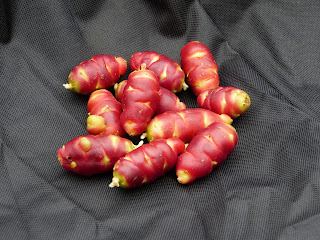I mentioned yesterday that I went down to check on the bees Saturday and I saw a swarm attached to a tree branch. I went up to the cabin to get some supplies and by the time I got back they were gone. I assumed they had left, but now I am thinking they may have gone back into the hive. I have heard that if you see your bees are about to swarm you can clang a pot and pan together to mimic the sound of thunder and sometimes the bees will move back into the hive. They do not want to swarm before a storm. It was raining Saturday, but I do not remember any thunder. I was surprised to find the swarm on a branch of the same tree when I arrived home yesterday.
A little info about swarms... When a swarm starts it will only fly a very short distance from the hive where the queen will send out 20-50 scout bees. The scout bees will inspect sites for their new home. The scouts return and perform a dance.. the more excited the scout is about the location the more enthusiastic the dance is. The scout tries to entice the other scouts to go with it to visit the site. It may take a few hours or a few days for all of the scouts to agree on the same location. At this time the swarm leaves for its new home.
This is a closeup of the swarm. It is hard to say how many bees are in the cluster but I would guess about 15000 bees. Sound hard to believe? When you order a package of bees you typically get a 3 lb package which is about 10,000-12,000 bees. I have ordered a few packages in the past and this swarm was slightly larger than what would come in a package.
I quickly grabbed my supplies (suit, gloves, hive components, and shears). I set the new hive up and then while holding the branch with one hand I carefully used my shears to cut the branch away from the tree. I slowly walked with the cut branch and swarm over to the new box. I placed the limb on the hive and then slowly started brushing the bees off of the branch (see brush in picture below).
After most of the bees were in the new box I closed the box. I have my fingers crossed that the bees will stay. I think often times people take a frame of brood from one of the existing hives to install into the new hive. I will check this afternoon to make sure the bees are still here and if they are I will give them a few days to settle in before going into the hive.














